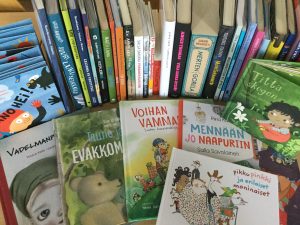Societal themes highlighted in children’s and youth literature – more books published, more girls than boys as the protagonist in Finnish books
Kirjakori exhibition opens on Thursday 5th of April at The Finnish Institute for Children’s Literature. The exhibition showcases children’s and youth literature from 2017, complete with statistics based on the material. According to the annual Kirjakori statistics, the amount of published books for children and youth was slightly on the rise during 2017. This Kirjakori encompasses 1257 titles, amounting to 200 more books than the previous year. For the first time the amount of domestic books surpassed the translations, with 52% majority. Domestic picture books, children’s novels, youth novels and nonfiction increased in number compared to the previous year.
Themes present in societal discussions were clearly visible in the children’s and youth literature of 2017. Environmental consciousness, climate change, war experiences, refugeehood and immigration appeared in picture books as well as children’s and youth novels. Equality, feminism and tolerance were examined from multiple perspectives both in fiction and nonfiction. Sexual harassment discussed around the Me Too campaign was present in youth literature.
Finland’s 100 years of independence was celebrated both in stories and by various jubilee publications. As for depictions of families, absent parents were a recurrent theme. Within picture books and novels, both parents were either physically or mentally absent, leaving the children neglected. Several books aimed to help children of different ages to recognize and regulate their feelings.
Throughout 2017 there was an ongoing discussion on the decline of literacy and the importance of reading. The value of literature and books is highlighted also in the contents of last year’s children’s and youth literature The concern for boys’ declining reading is yet to manifest itself in the choices for main characters in domestic titles. The Finnish picture books, children’s books and youth novels all have a majority of girls as their protagonist. The greatest difference appears within children’s literature: 40 books with a female main character compared to 20 with a male. In some of last year’s books the protagonist is a child whose gender is ambiguous.
Kirjakori exhibition is open to public at the library of The Finnish Institute for Children’s Literature from 5.4. to 18.5. Opening hours: Mon 10-17, Tue-Fru 10-15 or by appointment (April 30th 10–15, closed May 10th–11th). The Kirjakori 2017 overview and statistics are based on publishers’ contributions to the library collections of The Finnish Institute for Children’s literature.
Translation: Aino-Maria Kangas

